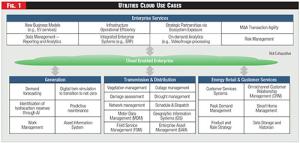Accenture
Siddharth Purohit is a Senior Manager in Accenture’s Technology Strategy & Advisory practice. He focuses on Enterprise Agility, Technology Value Realization and Cloud Acceleration & Innovation for the Resources industries. Debanjan Chakraborty is a Managing Director in Accenture’s Technology Strategy & Advisory practice. He focuses on Enterprise Agility, Technology Value Realization, Cloud Acceleration & Innovation and Data Led Transformation for the Resources industries. Ruari Monahan is a Managing Director in Accenture’s Strategy & Consulting practice for Utilities. As the global CloudFirst lead for Utilities, he focuses on business transformation through large scale implementation and migration via cloud enablement.
Utilities lag significantly behind other industries in adopting cloud computing, primarily because of the disincentives imposed by traditional regulatory accounting. Cloud computing, however, has tremendous value propositions in driving safe, clean, and affordable utility services and infrastructure, which are the very premises the regulatory bodies want to ascertain.

Major industry trends, such as decarbonization, decentralization, and democratization are strongly underpinned by digital technologies and the cloud provides the essential framework on which utilities can build their innovation capabilities.
This article discusses the urgency for utilities and regulators to accelerate their journey to the cloud and the steps to be taken to embark on that journey.
Cloud Value Proposition to Utilities
Cloud computing drives business agility by enabling rapid deployment of technology solutions to dramatically increase speed to value. Most software vendors now offer cloud-native Software-as-a-Service solutions that are managed by the vendors to evolving industry best practices, freeing up valuable time for utility employees. Public cloud also provides access to many prepackaged marketplace applications that can be quickly procured and leveraged to solve business problems and enhance customer experience.
Cloud computing greatly enhances the operational efficiency of a utility's infrastructure operations. A traditional utility spends over fifty percent of its technology budget on infrastructure, which includes data centers and networks.
 Figure 1 - Utilities Cloud Use Cases
Figure 1 - Utilities Cloud Use Cases
They also need to accommodate for resiliency in the design of infrastructure to ensure undisrupted business operations in case of disasters. Cloud improves the reliability, availability, serviceability, and resiliency of infrastructure while providing elastic consumption and pricing models. This allows utilities to use resources efficiently.
The fourth industrial revolution offers a multitude of innovative technologies that are radically changing the way we live our lives and operate our businesses. Cloud provides the enabling platform to leverage many emerging technologies such as artificial intelligence (asset health prediction), drones and robotics (damage assessment patrols), augmented and virtual reality (employee training to combat real-life workplace situations), and blockchain (smart contract in EV charging) to drive business outcomes.
Most emerging utility business models are focused on customer-centric products and services, transition to renewables, and smart operations. Customer-facing technologies (smart meters), renewable-related models (distributed energy resources), and smart operations (digital twins) are all characterized by a decentralized infrastructure that generates a tremendous volume of data. Cloud provides the capability to seamlessly converge, process, and harvest this data to deliver valuable business insights.
Finally, the adoption of new-generation technologies like the cloud will help in recruiting and retaining a new-generation workforce. Replacing the aging workforce with the emerging generations such as millennials has been a major challenge
for utilities.
 Siddharth Purohit: Decarbonization, decentralization, and democratization are strongly underpinned by digital technologies and the cloud provides the framework.
Siddharth Purohit: Decarbonization, decentralization, and democratization are strongly underpinned by digital technologies and the cloud provides the framework.
The next tech-native generations of the labor force, Generations Z and Alpha, would be far less likely to choose a career in utilities, unless the industry changes the perception of being a laggard in technology adoption and provides a culture of continuous innovation and growth.
Barriers to Adoption
Traditional regulatory accounting inhibits utilities to earn a rate of return on their cloud investments because of the typical pay-as-you-go pricing model of the public cloud providers. Utilities and regulators should work together to remove this barrier. There are potential approaches to authorize a return on avoided capital investments toward building on-prem computing infrastructure.
These are akin to revenue decoupling or lost revenue adjustment policies related to energy efficiency that has been adopted by many regulatory bodies. Some options to capitalize cloud expenses and add costs to the rate base could be full payment up front for the services used, which would be amortized over a defined period, intermittent payment over a defined period resulting in declining amortization, and a hybrid solution based on the above two methods for a fixed base and dynamic workloads.
A different approach could be to keep cloud services as operating expenses. To achieve this, a flat fee can be included in the rates based on cloud consumption to account for lost revenue by not investing in on-premises solutions.
 Ruari Monahan: There are potential approaches to authorize a return on avoided capital investments toward building on-prem computing infrastructure.
Ruari Monahan: There are potential approaches to authorize a return on avoided capital investments toward building on-prem computing infrastructure.
Instead of waiting on policy change, utilities should embark on their cloud modernization journey by focusing on non-critical and stable loads (such as enterprise applications) where the major component of the project is operating-expense driven or by leverage capabilities such as full upfront payment where allowed.
There is a misperception that the cloud is less secure than on-premises data centers. However, major Cloud Service Providers are more secure than an individual utility can be (such as the Central Intelligence Agency's use of the cloud across all security levels). Changing this perception requires education and a cultural shift across the organization.
Concerns about vendor lock-in are another often cited barrier to cloud adoption. This can be mitigated by using a multi-cloud strategy and defining modern architecture. Current investments in on-premises infrastructure also sometimes create a barrier to cloud adoption. This can be mitigated by enabling a phased migration approach by considering factors such as data center age, application dependencies, and ease of implementation.
Use Cases
The decision to adopt cloud goes beyond the ability to recover cloud investments. Cloud enables use cases by providing a platform for new business models (electric vehicle services), emerging technologies (digital twin), third-party solutions (vegetation management), and hosting an application (meter data management) to name a few. In Figure 1 are some of the use cases across the utility value chain that can leverage cloud capabilities.
Path to Transformation
 Debanjan Chakraborty: The next tech-native generations would be less likely to choose a career in utilities, unless the industry changes the perception of being a laggard in tech adoption.
Debanjan Chakraborty: The next tech-native generations would be less likely to choose a career in utilities, unless the industry changes the perception of being a laggard in tech adoption.
Utilities must establish a structured fit-for-purpose transformation path for their cloud journeys to maximize benefits. Many times, organizations take a piecemeal approach only focused on cost savings, but that leads to sub-optimized outcomes and disillusionment about cloud value.
To shift strategies from digitization and SaaS to developing intellectual property, integrated and seamless solutions, value from data, and strategic third-party partnerships to meet customer needs at speed, an enterprise-wide cloud strategy needs to be defined and driven by business use cases.
To plan for the transformation program, conduct a current state assessment, identify gaps, establish a to-be state, and establish a prioritized roadmap for the cloud journey. Start with a crawl, walk, and run approach for the cloud transformation journey to incrementally improve the capabilities that provide the most business value.
An Intelligent Operating Model should be defined to support business models enabled by cloud transformation. Establish Cloud FinOps processes and tools to increase cost allocation visibility, define optimization opportunities, and take actions to achieve optimization goals through cross-functional collaboration leading to a more product-centric approach to the total cost of ownership.
Most important, prioritize people and culture as a part of the cloud transformation journey, which can lead to sixty percent greater value. The key to success is a focus on alignment with the C-suite, the ability to upskill and source talent, and the adoption of agile Operating Models.
Closing Remark
To thrive in the future, utilities and regulatory bodies will have to make bold moves to enable new business models and optimize their business operations to transform into modern and resilient enterprises.
Utilities that embrace cloud technologies are better prepared to respond to changing customer expectations, technological innovation, meet sustainability goals, and address the talent gap. As the work continues to remove barriers to cloud adoption in regulated utilities, there are mechanisms as discussed in the paper that utilities can leverage to continue their cloud transformation journey.
A thoughtful path to transformation with business-led use cases can lead to the top and bottom-line growth, customer, and employee experience.



